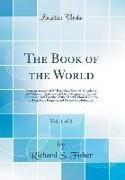- Start
- The Book of the World, Vol. 1 of 2
The Book of the World, Vol. 1 of 2
Angebote / Angebote:
Excerpt from The Book of the World, Vol. 1 of 2: Being an Account of All Republics, Empires, Kingdoms, and Nations, in Reference to Their Geography, Statistics, Commerce, and Together With a Brief Historical Outline of Their Rise, Progress, and Present Condition, EtcThe Ethiopic or Black race, have the head narrow, and the forehead convex and vaulted, the cheek bones projecting, the nostrils wide, the jaws long, the skull generally thick and heavy. The lips, particularly the upper one, are very thick, the jaws prominent, and the chin retracted The skin of this class, and the iris, are deep black, the hair black and woolly. These characteristics are very uniform. The Ethiopic races inhabit Central and Southern Africa, Australia, and some of the Oceanic islands.The American family approaches the Mongolian. This is fully de~ scribed in. Another place.The Malays have the top of the head slightly narrowed, the forehead a little arched, the cheek bones not prominent, the upper jaws a little pushed forward, and the prominence of the parietal bones strongly marked. The face is less narrowed than that of the negro, somewhat advancing in the lower part, when seen in profile the features are more prominent, the nose full, broad and thick towards the point, or what is called a bottle nose the skin is tawny, the hair black, soft, curled, and abundant. In this class are comprised all the natives of the islands in the Pacific Ocean: (excepting those already mentioned as belonging to the Ethiopic class likewise the dominant nations of the Indian Archipelago.Such is Blumenbach's classification, which has been very generally adopted. Some naturalists, among whom is Cuvier, reduce the classes to three, considering the Malay to be only a sub-variety of the Caucasian, and the American as a variety of the Mongolian. Others carry the number to eleven or fifteen classes, and not without reason, for all the tribes come prised under each of Blumenbach's five classes, so far from having exactly the same characteristics, really differ in some cases from each other as much as the class under which they are ranged differs from the other classes. All classification, indeed, must be arbitrary, but this branch of science is only in its infancy, and the little progress that has been made in its study, leaves a wide field for the inquiring naturalist.About the PublisherForgotten Books publishes hundreds of thousands of rare and classic books. Find more at www.forgottenbooks.comThis book is a reproduction of an important historical work. Forgotten Books uses state-of-the-art technology to digitally reconstruct the work, preserving the original format whilst repairing imperfections present in the aged copy. In rare cases, an imperfection in the original, such as a blemish or missing page, may be replicated in our edition. We do, however, repair the vast majority of imperfections successfully, any imperfections that remain are intentionally left to preserve the state of such historical works.
Folgt in ca. 10 Arbeitstagen

